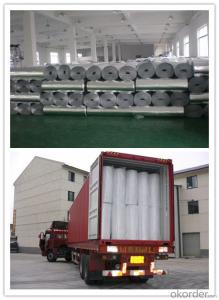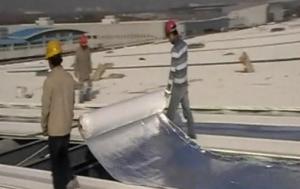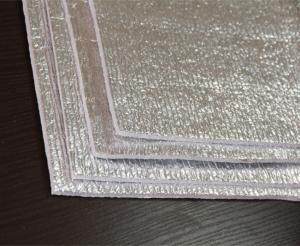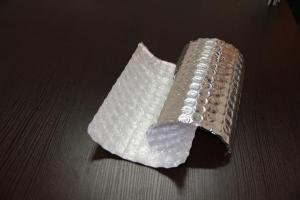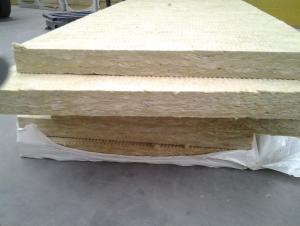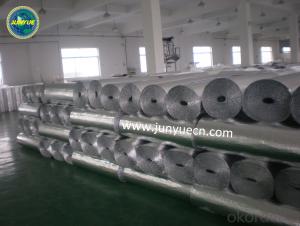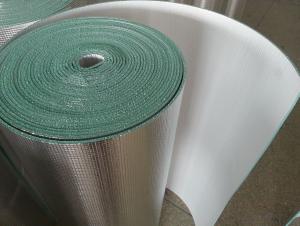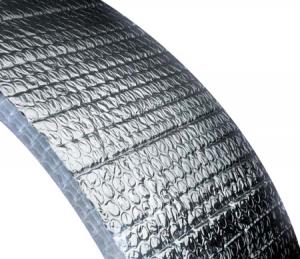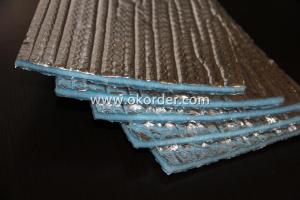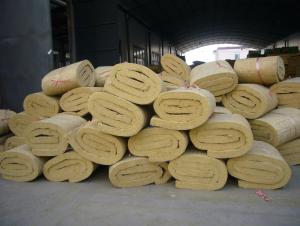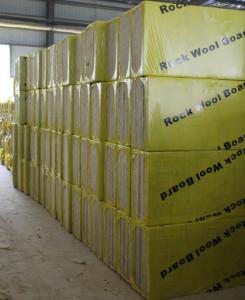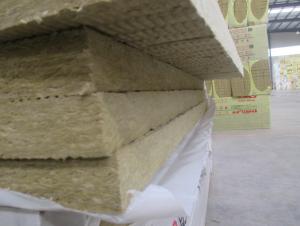bubble insulation with foil
- Loading Port:
- Shanghai
- Payment Terms:
- TT OR LC
- Min Order Qty:
- -
- Supply Capability:
- 10 m²/month
OKorder Service Pledge
OKorder Financial Service
You Might Also Like
This is a new environmentally friendly aluminum foil bubble heat insulation material, which is soft, light and easy to install. It is made from aluminum foil and polyethylene through special machinery.
Function:
Can be installed on roof, wall or floor, resist over 80% external heat from buildings, protect wall, resist thermal shock and sudden cold, etc.
Characteristics:
1.No odor and toxicity, environmentally- friendly;
2.Moisture barrier, sun-proof, waterproof, good sealing property, heat preservation, energy saving…
3.Heat reflection, heat insulation, sound insulation, anti-radiation, anti-vibration, and shielding;
4.Light, soft, dust free, fire retardant, easy to install;
5.Summer: moisture barrier, sun-proof, heat insulation, saving energy consumed by cool air conditioning ;
6.Winter: heat preservation, central heating saving, and remarkable energy-saving effect.
Product: fireproof material
Technical parameters:
Material structure: AL/bubble/AL | ||
Bubble size: ¢10mm, H 4mm | ||
Bubble weight: 0.13 KG/M2 | ||
Roll size: 1.2M W*40M L (can be customized) | ||
PROPERTIES | Test Data | Unit |
Thickness | 3.5 | MM |
Weight | 256 | G/M2 |
Emissivity | 0.115 | COEF. |
Thermal conductivity | 0.034 | W/M0 |
Apparent Density | 85 | KG/M3 |
Reflectivity | 95-96 | % |
Water Vapour Transmission | 0.013 | G/M2 KPA |
Corrosion | Doesn't generate | |
Tensile strength (MD) | 16.98 | Mpa |
Tensile strength (TD) | 16.5 | Mpa |
Usage:
1. Roof, wall, floor;
2. Shells of air conditioner and water heater;
3. Protective coatings of water pipe and ventilating pip
- Q:The roof does not have fillet under tiles, our house tends to be very cold and we want to remove the insulation and put a knew one, will our house be warm? any tips and advice.thank you for your time
- I was an insulation installer for a time and this is what we did. We never took out old insulation; this is even when we blew it into the walls. We used cellulose wood fiber aka recycled paper preferable news paper and phone books. After the stuff was ground up Borax and Boric acid was added to make it fire proof. This stuff was blown in on top of the old stuff, usually 6 to 8 inches. All you do is have one person in the attic who sits down, with a hose in hand you plow it in and take measurement as you move along to be sure it is the thickness you want. Try to keep it even and smooth (like icing a cake). The other person stands next to the blower, which is place outside our in the garage (ours was in the back of a truck). This person must keep the hopper full and walk from the blower to the attic to physically look at you for safety reasons. Both must were face mask over your mouth and nose, you may want to wear goggles as well. I didn’t like goggles because they fogged up. Before you start work out emergency calls and other communication. We did this by turning the blower on and off with the remote switch (which you must have in the attic). If you take the square footage of your attic to the store the sales person can tell you how much you need. This info use to be on the back of the bag and it is easy to do. Make sure you have the correct number of roof vent for the square footage of your space. Have a fun time doing it and it will be over in no time! The blowers may have the formula to figure how much you can do per square foot per hour. This will let you budget your time better, remember that formula is usually how much can be blown per hour; the other task will eat into that time frame. To do the side walls is a bit more involved, but if you need help with that as well I would be glad to tell you the details.
- Q:Finally remembering to do so, before my family and I left the house for approximately 4 hours, I turned off the heat before leaving. When we came home I turned it back on, but was shocked to see that the temperature had dropped 4 degrees in that time. 4 degrees in just under 4 hours seems like a lot of heat loss, does it not? I've seen the insulation in our roof and it's just that sawdust looking stuff spread everywhere. I feel like I'm paying a lot of unnecessary dollars for heating: the air does kick on every hour or two and we keep the thermostat at 68.Is it reasonable for me to talk to my landlord about this problem and getting better insulation in the ceiling, and maybe in the roof? (the master bedroom, on the far corner of the house, is always 2-3 degrees below the rest of the house). Are my expectations to not lose a degree of heat or more per hour unreasonable? Would a typical landlord consider this a problem worth discussing?
- I never turn my heat or ac off when I leave the apartment. I'd say you can ask all you want but the landlord won't be listening to you. And I don't think 4 degree drop is a lot. And it does depend on what the weather outside is. If I had 68 degrees indoors I'd always have a cold. What is your monthly bill and which part of the country are you in? My bill is around $42 a month. I have insulated draperies, I use only one 40 watt bulb at my place. When it gets cold in here my 40 watt bulb will heat my place.
- Q:We bought a house and put new metal roof on over the shingles. (first please don't say, this or that should have been done, just what I can do now) Any how, we have put a lot of money into the house, roof, all new electrical, all new plumbing, etc., I had to make the house in a "living in condition" with a low budget. ............ the house does not have insulation in ceilings, this has to be done next summer. (budget) Any how, the metal roof has condensation under it, only in the ridge vent area. This drips a little and I need to fix it. Now, I know that insulation wouldprobablyy fix this, but we don't have the money right now, so I need help on what to do? Is there anything that with a $100 to $200 budget can be done? I have searched a little, and maybe use a "spray-on"insulation help? The area is where the gap is at the peak and where themetall overlaps the ridge vent. (I thinkthat'ss what it's called)Thank you! :)
- hope this helps. With more air movement there will not be so much condensation. it is a matter of having an inlet for air or a fan and then an outlet for air. There are small extractor fans i have one for my bathroom, but unsure of the cost.
- Q:I am purchasing a mobile home with a shingled roof. The shingles need to be replaced (>15yrs old) and with the cost of heating going up each day I thought I would added some of that 2" thick rigid insulation. I would place this right on top of the existing roof and then place the firring strips for the metal roof right on top of the rigid insulation panels (which are 4x8'). By using 3" galvanized sheet rock screws I will get a good solid attachment. Then I will put the metal roofing on to the firring strips as normal. Does anyone see any downside to doing this? Has anyone tried this before?
- I agree with the soundness of every part of your plan EXCEPT not removing the original shingle roof. The shingle roof is already at the end of its usable life. There’s no benefit to covering up old problems, and they will most likely affect the durability of the new roof. Plus, removing the old roof gives you the opportunity to inspect and repair any issues with the roofing deck. Your new insulation and metal roof will attach better and perform better by removing the old shingle roof.
- Q:I am building a porch roof over an existing patio. The rafters are fabricated I-beams. I plan on putting aluminum soffit under the I-beams. On top of the roof I would like to put down a metal roof. I already put down 3/4" OSB and a rain/ice barrier. Do I need insulation and/or ventilation on top of the rain and ice barrier, or can I get away without it?
- You don't need insulation for this application. If you haven't purchased the metal yet I would recommend looking for a standing seam roof system that the panel does not come in contact with the substrate and does not use exposed fasteners. If in the future you did decide to enclose the porch and add heat you could insulate the ceiling and leave an air space under the decking that could be ventilated from the eave to the ridge. A cold roof assembly with proper ventilation will dramatically reduce the potential of the metal panels sweating.
- Q:Foam and the new building technolodgy's are coming to New Orleans. The rebuilding is causing New Orleans to be the "Greenest City in America". Energy Efficiency and the proper buiilding techniques tak hold.
- foam is great but ugly as hell
- Q:I have a valley between two roof peaks that gets a huge icicle every year. I know this area is not insulated very well. In the house it is a dead area between two rooms. I would like to get someone over here and blow it full of insulation (couple calls in, awaiting response). In the meantime, I do have heat tapes installed on the roof in this area. It's a 50' run, zigzagged and some goes into gutter and the downspout.I am paranoid of fire hazards and have a real problem leaving these tapes plugged in. That being said, I realize snow is all around and water is flowing in this case. Is it safe to leave these plugged in?Is there a time I should be unplugging?Will this help my icicle problem?Serious replies only please. I prefer from a licensed contractor/insulator.Thanks in advance.
- James M has a good answer- Your problems (as mine) are found in the attic - or below the roof surface. If the roof is warmed from within the house, the snow will melt daily and re-freeze at night. Your task is to keep the roof COLD by insulating the eaves from warm air. Also the attic space. The attic air should rise to a vent in gables or along the roof ridge... then exit. The interior temperature should be chilly at all times with snow on the roof- 40degF or below. In my case (maybe yours?), the warmth comes from the Top of the exterior walls - the top plate is very near the roof- and heat from the living space travels upward inside the wall to this support... a LINE of snow melt is visible where the wall meets the roof. I need to reinsulate the entire exterior to get control of roof snow melt... or visit the roof with a snow rake after heavy snow.
- Q:i have about 200 sq ft of odd shaped polystyrene foam (rigid) insulation between 3" and 5" thick. it's leftover from installing a flat roof on a commercial building. creative ideas anyone? grind it and use it as attic insulation in a home?thanks.
- put an AD and sell it as material for Accoustic sound proofing,
- Q:attic is 400 sq ft.there are 4 round 6'' Vents in soffit,and 2 roof vents-12"x12".Rock wool,blown in,R/30 NO VAPOR BARRIER.Why the mold?no gable or ridge vent either.How do i fix this?There are baffles in attic,rafters are not blocked.
- is your HVAV unit in the attic?Is the moisture coming from it? Also-ridge vents help allow proper ventilation.
- Q:the roof of my mouth hurts bad.i worked all day with sawdust and insulation yesterday.is this the problem.?
- The okorder , and see if I could find out anything there, if not I'd see my doctor. Insulation can get into your lungs and nasal passages and do a great deal of damage. That's why you should always wear a mask when woking with it. I would'nt worry too much about the sawdust.
1. Manufacturer Overview |
|
|---|---|
| Location | |
| Year Established | |
| Annual Output Value | |
| Main Markets | |
| Company Certifications | |
2. Manufacturer Certificates |
|
|---|---|
| a) Certification Name | |
| Range | |
| Reference | |
| Validity Period | |
3. Manufacturer Capability |
|
|---|---|
| a)Trade Capacity | |
| Nearest Port | |
| Export Percentage | |
| No.of Employees in Trade Department | |
| Language Spoken: | |
| b)Factory Information | |
| Factory Size: | |
| No. of Production Lines | |
| Contract Manufacturing | |
| Product Price Range | |
Send your message to us
bubble insulation with foil
- Loading Port:
- Shanghai
- Payment Terms:
- TT OR LC
- Min Order Qty:
- -
- Supply Capability:
- 10 m²/month
OKorder Service Pledge
OKorder Financial Service
Similar products
New products
Hot products
Related keywords
